Easy care indoor hanging plants are a beautiful and practical way to add life and style to your home. They can purify the air, reduce stress, and add a touch of nature to any room. With a little care, they can thrive for years to come.
In this guide, we will discuss the most popular easy-care indoor hanging plants, their benefits, and how to care for them. We will also provide some tips for styling and displaying your hanging plants, as well as some DIY projects and tutorials.
Popular Easy-Care Indoor Hanging Plants
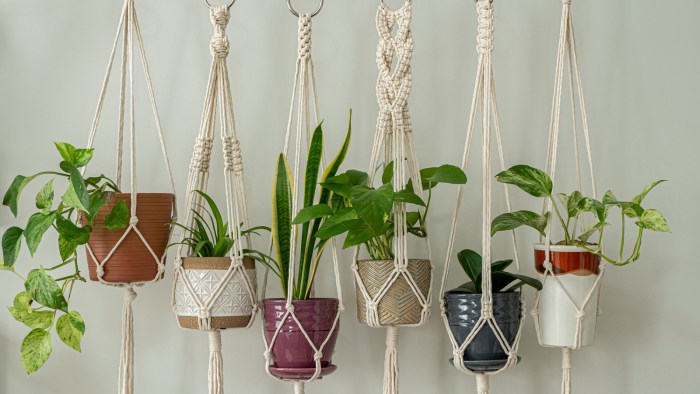
Indoor hanging plants are a great way to add life and color to your home without taking up too much space. They’re also relatively easy to care for, making them a good choice for busy people or those who don’t have a lot of experience with plants.
Some of the most popular easy-care indoor hanging plants include:
Spider Plants
- Spider plants are known for their long, trailing stems that produce baby plants, or “spiderettes”.
- They’re very adaptable and can tolerate a wide range of light conditions.
- They prefer to be watered when the soil is dry to the touch.
Pothos
- Pothos is another popular choice for hanging baskets.
- It has heart-shaped leaves that come in a variety of colors, including green, white, and yellow.
- Pothos is very tolerant of neglect and can even survive in low-light conditions.
String of Pearls
- String of pearls is a unique succulent that has long, trailing stems covered in small, bead-like leaves.
- It prefers bright, indirect light and should be watered sparingly.
- String of pearls is a great choice for adding a touch of whimsy to your home.
Choosing the Right Hanging Plant
When choosing a hanging plant, it’s important to consider the amount of light your space receives, as well as the size and shape of the plant.
If you have a small space, you’ll want to choose a plant that is relatively compact. If you have a lot of light, you can choose a plant that is more vigorous and trailing.
No matter what your needs, there’s sure to be an easy-care indoor hanging plant that’s perfect for you.
Benefits of Indoor Hanging Plants
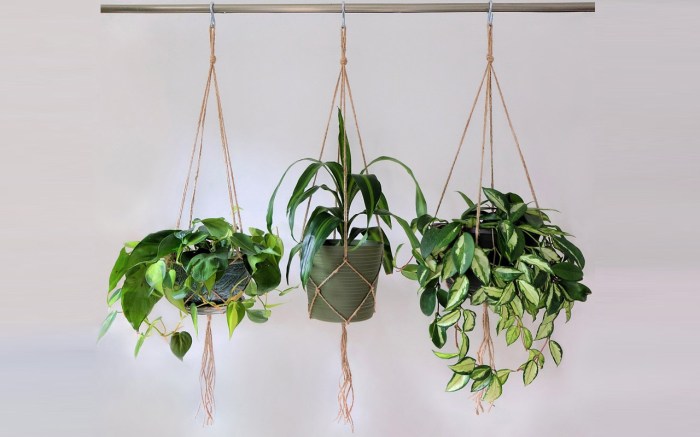
Indoor hanging plants are not only aesthetically pleasing but also offer numerous benefits for your health and well-being.
These plants can help purify the air, improve mood, and reduce stress levels.
Aesthetic Benefits
Hanging plants add a touch of greenery and create a sense of height in a room.
They can be used to soften harsh corners or fill empty spaces.
Air-Purifying Qualities
Certain hanging plants, such as spider plants and peace lilies, have been shown to remove toxins from the air.
This can help to improve air quality and reduce the risk of respiratory problems.
Mood Enhancement
Studies have shown that exposure to plants can improve mood and reduce stress levels.
Easy care indoor hanging plants can add a touch of greenery and freshness to any room. For those with limited space or time, Hanging Plants offers a wide selection of low-maintenance options. From trailing pothos to cascading ferns, these plants can bring life and beauty to any indoor space with minimal effort.
Hanging plants can create a calming and relaxing atmosphere in a room.
Easy-care indoor hanging plants bring life and a touch of nature into your home. If you’re looking for a unique way to display your plants, consider creating your own DIY indoor wall planters. 5 DIY Indoor Wall Planters to Bring Life to Your Walls provides step-by-step instructions for creating stunning wall planters using materials like wood, macrame, and recycled items.
These planters not only showcase your plants but also add a decorative element to your walls, making them a perfect addition to any room in your home.
Care and Maintenance for Indoor Hanging Plants
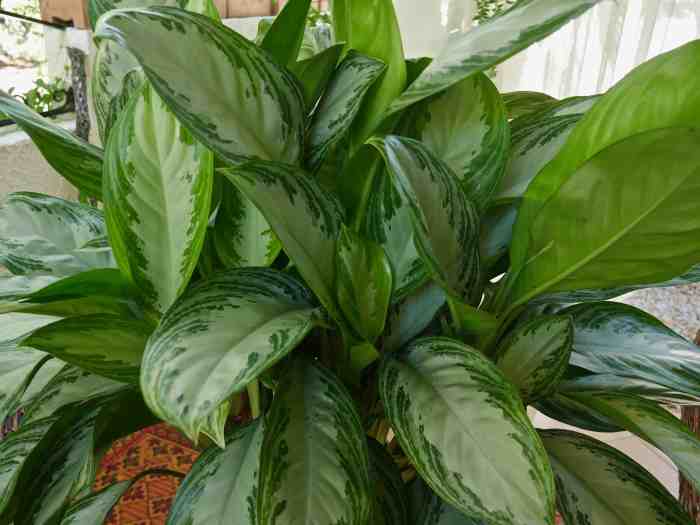
Maintaining indoor hanging plants requires specific care to ensure their health and aesthetic appeal. By understanding their watering, fertilizing, and pruning needs, as well as effective pest and disease management strategies, plant enthusiasts can keep their hanging plants thriving.
Watering
The frequency of watering hanging plants depends on factors such as plant species, pot size, and environmental conditions. Generally, plants with thick, succulent leaves require less frequent watering than those with thin, delicate leaves. It’s crucial to avoid overwatering, as it can lead to root rot.
Allow the top inch of soil to dry out before watering thoroughly.
Fertilizing
Fertilizing hanging plants provides essential nutrients for healthy growth. Choose a balanced liquid fertilizer and apply it according to the manufacturer’s instructions. During the growing season (spring and summer), fertilize monthly. Reduce fertilization frequency during fall and winter.
If you’re seeking low-maintenance greenery to enhance your indoor space, consider easy-care indoor hanging plants. For a dramatic cascading effect, explore “5 Drape Plants for a Lush Indoor Oasis” here . These plants not only add visual interest but also purify the air, creating a serene and healthy indoor environment.
Pruning
Regular pruning encourages healthy growth and prevents plants from becoming leggy. Remove dead or damaged leaves and stems. Trim back overgrown branches to maintain the desired shape and size of the plant.
If you’re looking for easy-care indoor hanging plants, consider the five varieties featured in the article 5 Draping Indoor Plants for Low Light: Beautify Your Space with Minimal Effort . These plants are perfect for adding a touch of greenery to your home without having to worry about constant maintenance.
Whether you’re a seasoned plant parent or a novice, these low-maintenance options are sure to thrive in your indoor space.
Pest and Disease Management
Indoor hanging plants can be susceptible to pests and diseases. Common pests include aphids, mealybugs, and spider mites. Regularly inspect plants for signs of infestation and treat promptly with insecticidal soap or neem oil. Diseases like powdery mildew and root rot can be managed by improving air circulation and avoiding overwatering.
Specific Care Requirements for Popular Hanging Plants
Different hanging plants have unique care requirements. Here’s a table summarizing the specific needs of some popular varieties:
| Plant | Watering | Fertilizing | Pruning |
|---|---|---|---|
| Spider Plant | Water when top inch of soil is dry | Monthly during growing season | Remove dead or yellowed leaves |
| Pothos | Water when top 2-3 inches of soil are dry | Every 2-3 months | Trim back long stems to encourage bushier growth |
| Ferns | Keep soil consistently moist but not soggy | Monthly during growing season | Remove brown or damaged fronds |
| String of Pearls | Water sparingly, allowing soil to dry out completely between waterings | Fertilize every 2-3 months | Remove any dead or discolored stems |
| Air Plants | Mist regularly, or soak in water for 20 minutes once a week | No fertilizing required | Trim brown or dead leaves |
Styling and Display Ideas for Indoor Hanging Plants: Easy Care Indoor Hanging Plants
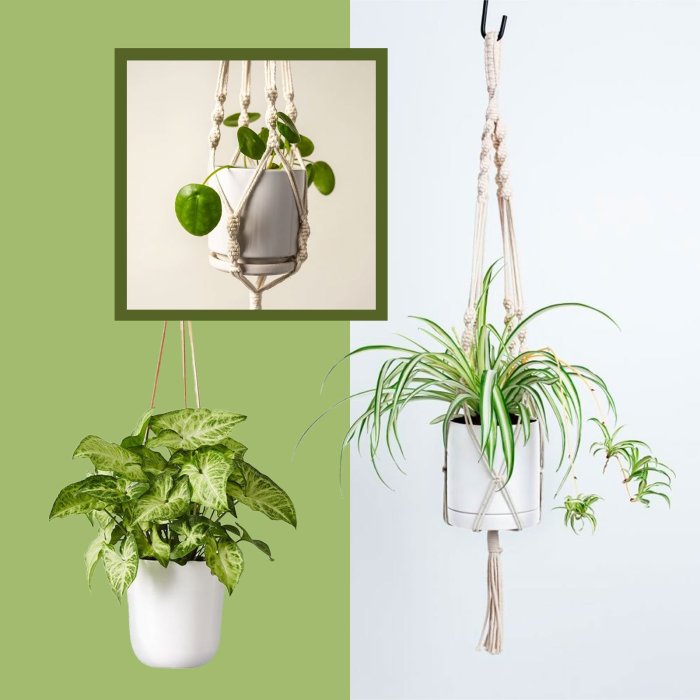
Elevate your home decor with stylish hanging plants that bring a touch of nature and freshness to any room. Explore creative ways to display these plants, creating eye-catching vertical gardens and transforming your living space into a verdant oasis.
Living Rooms
- Hang macrame planters from the ceiling to create a bohemian vibe.
- Suspend trailing plants like pothos or philodendron from a corner to add lushness and greenery.
- Install a hanging shelf with multiple levels to showcase a variety of plants, creating a focal point in the room.
Bedrooms
- Hang a small plant from the headboard to add a calming touch to your sleep space.
- Suspend a trailing plant from the ceiling near a window to let the natural light filter through its leaves.
li>Create a canopy of hanging plants above the bed, providing a sense of tranquility and relaxation.
Kitchens
- Hang herbs like basil, mint, or rosemary near a sunny window for easy access while cooking.
- Create a vertical garden on the wall using hanging planters, growing fresh produce for salads or garnishes.
- Suspend a trailing plant like ivy or fern from the ceiling to add a touch of greenery and freshness to the kitchen.
Vertical Gardens and Plant Walls
Maximize space and create a living wall by installing hanging planters vertically. Use different sizes and shapes to add depth and interest to the display. Consider plants with varying textures and colors to create a dynamic and eye-catching effect.
DIY Projects and Tutorials for Indoor Hanging Plants
The DIY (do-it-yourself) approach to home décor has gained popularity, offering opportunities for creativity and personalization. Creating indoor hanging planters is one such project that allows individuals to add a touch of greenery to their homes while engaging in a fun and rewarding activity.
For those looking to embark on DIY projects involving indoor hanging plants, numerous resources are available online, providing step-by-step tutorials and inspiration for various techniques.
Macrame Plant Hangers
Macrame, an ancient art of knotting cords or strings, can be utilized to create elegant and intricate plant hangers. Online tutorials guide users through the process of selecting suitable cords, tying basic knots, and assembling the hanger. With patience and practice, individuals can create unique and stylish macrame plant hangers that complement their home décor.
Yarn Plant Hangers
Yarn, a versatile material commonly used for knitting and crocheting, can also be employed to make charming plant hangers. Tutorials demonstrate techniques such as wrapping yarn around a ring or dowel, creating intricate patterns, and adding tassels or beads for embellishment.
Yarn plant hangers offer a cozy and bohemian touch to any room.
Repurposed Item Plant Hangers
Repurposing everyday items into plant hangers adds an element of sustainability and creativity to home décor. Tutorials provide ideas for transforming items such as old jars, cans, or baskets into unique hanging planters. By drilling holes or attaching hooks, individuals can create functional and stylish plant hangers that showcase their resourcefulness.
Propagating Hanging Plants
Propagating hanging plants is a rewarding way to expand one’s plant collection. Tutorials guide users through methods such as stem cuttings, air layering, and division, providing step-by-step instructions for successful propagation. By following these tutorials, individuals can create new hanging plants from their existing ones, adding to the beauty and diversity of their indoor greenery.
Hanging Plant Terrariums, Easy care indoor hanging plants
Terrariums, miniature ecosystems enclosed in glass containers, can be suspended to create stunning hanging displays. Tutorials offer guidance on selecting suitable plants, creating a balanced environment within the terrarium, and maintaining its health. Hanging plant terrariums bring a touch of nature indoors, providing a low-maintenance and visually appealing addition to any home.
Final Wrap-Up
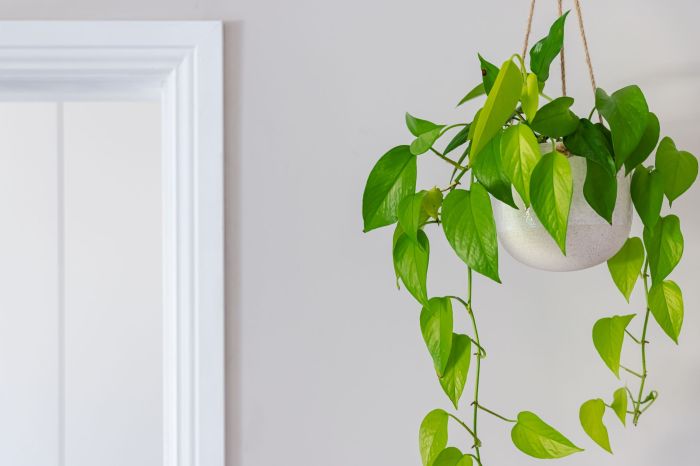
Hanging plants are a great way to add beauty and style to your home. They are easy to care for, and they can provide many benefits, including improved air quality, reduced stress, and a sense of well-being. So if you are looking for a way to add some life to your home, consider adding a few hanging plants.
Question & Answer Hub
What are the most popular easy-care indoor hanging plants?
Some of the most popular easy-care indoor hanging plants include pothos, spider plants, philodendrons, and ferns.
What are the benefits of indoor hanging plants?
Indoor hanging plants can provide many benefits, including improved air quality, reduced stress, and a sense of well-being.
How do I care for indoor hanging plants?
Indoor hanging plants are generally easy to care for. They need bright indirect light, and they should be watered when the soil is dry to the touch.